
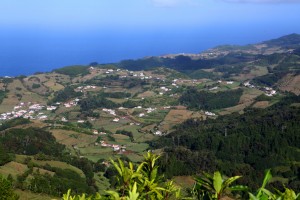 Santa Maria Island is the most southern and the warmest of the Azores Archipelago. It is like a little Portugal with a tropical climate in 97 square kilometres in the middle of the immense Atlantic Ocean. The West reminds the landscapes and plains of the Alentejo and the Algarve; the East has mountains full of vegetation similar to the North region of continental Portugal and to the other islands of Azores.
Santa Maria Island is the most southern and the warmest of the Azores Archipelago. It is like a little Portugal with a tropical climate in 97 square kilometres in the middle of the immense Atlantic Ocean. The West reminds the landscapes and plains of the Alentejo and the Algarve; the East has mountains full of vegetation similar to the North region of continental Portugal and to the other islands of Azores.

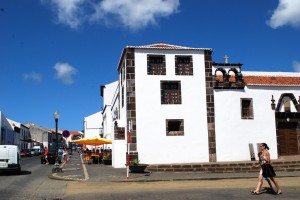
The exact data is not known but everything suggests that Diogo Silves, a Portuguese navigator, discovered it in 1427. What is known is that Gonçalo Velho Cabral has arrived to Santa Maria with a dozen crew fellows on 15 of August 1432, day dedicated to Our Lady of Assumption. In honour to the Virgin Mary, he has given the island her name, Santa Maria. A few years later came the first mainlanders to Praia de Lobos, followed by many others, especially from the southern regions of Portugal. The houses architecture is very similar to the one we encounter in Alentejo and Algarve, clearly observed by their chimneys.

 Santa Maria was also port of call in Christopher Colombo’s return from his first journey to the Americas. The legend claims the reason for that stop was to for fill the promise to pray to Our Lady in the first land he would see. After he has landed it is said, he was captured and remained governor’s prisoner until he explained the reasons for his scale. It was in the village called Anjos where today the natural swimming pools visited by little schools of fishes are the delights of all.
Santa Maria was also port of call in Christopher Colombo’s return from his first journey to the Americas. The legend claims the reason for that stop was to for fill the promise to pray to Our Lady in the first land he would see. After he has landed it is said, he was captured and remained governor’s prisoner until he explained the reasons for his scale. It was in the village called Anjos where today the natural swimming pools visited by little schools of fishes are the delights of all.

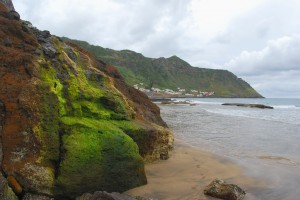 You will notice when you arrive in Santa Maria that almost everyone speaks English. A good part of the inhabitants of the island migrated to the United States and Canada in the 60’s or has family there. The airport, initially built by the Americans as a logistic base in World War II, is another reason and continues being one of the pillars of the economy of the island, developing commerce and tourism; You will also notice that the island is very clean and its inhabitants proudly keep their houses well painted and traditional basalt garden walls bordered white with detail.
You will notice when you arrive in Santa Maria that almost everyone speaks English. A good part of the inhabitants of the island migrated to the United States and Canada in the 60’s or has family there. The airport, initially built by the Americans as a logistic base in World War II, is another reason and continues being one of the pillars of the economy of the island, developing commerce and tourism; You will also notice that the island is very clean and its inhabitants proudly keep their houses well painted and traditional basalt garden walls bordered white with detail.



Although it is small, the island has a lot to see and do and consider at least one week so you can enjoy the most of it. Vila do Porto is the only municipality. The village goes from the Marina in nearly a single street 2 miles long, but there you will find everything you may need: pharmacy, restaurants, markets, stores and services. In Vila do Porto the main attractions are the medieval buildings, like the Forte de São Braz, a fortress and the several churches of the village. Also include the Centro de Interpretação Ambiental Dalberto Pombo in your visit plan and discover some more about species and fossils found on the island.
Other smaller towns sprinkle the island with the white of the houses and their stripes around the doors and windows traditionally collared differently depending on their village.


 Close to Anjos, on the North side of Santa Maria you will find the Barreiro da Faneca, also known as Red Desert, a protected area of red clay soil with basaltic lava and volcanic ash, which developed local pottery and was largely exported to the neighbour island of São Miguel.
Close to Anjos, on the North side of Santa Maria you will find the Barreiro da Faneca, also known as Red Desert, a protected area of red clay soil with basaltic lava and volcanic ash, which developed local pottery and was largely exported to the neighbour island of São Miguel.
The two only sandy beaches on the island are at Praia Formosa and Baía de São Lourenço. Praia Formosa is just a couple of miles from Vila do Porto and is a long stripe of golden sand.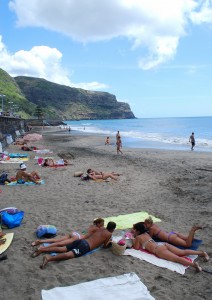 Baía de São Lourenço has also natural swimming pools where you can swim with the fishes and an amazing landscape of typical vines confined in basalt corral walls. The beaches and natural pools of Santa Maria Island have lifeguard surveillance during summertime.
Baía de São Lourenço has also natural swimming pools where you can swim with the fishes and an amazing landscape of typical vines confined in basalt corral walls. The beaches and natural pools of Santa Maria Island have lifeguard surveillance during summertime.

 In Malbusca just next to Praia Formosa, stands the Ribeira dos Maloás, a small water stream, with a 15 meter waterfall, about 220 meters from the ocean. It is one of the most beautiful visible remaining of the volcanic origin of Santa Maria. To get there you have a pedestrian route signalled as Calçada do Gigante, the name locals give it, which means giant’s path.
In Malbusca just next to Praia Formosa, stands the Ribeira dos Maloás, a small water stream, with a 15 meter waterfall, about 220 meters from the ocean. It is one of the most beautiful visible remaining of the volcanic origin of Santa Maria. To get there you have a pedestrian route signalled as Calçada do Gigante, the name locals give it, which means giant’s path.
The southernmost point of the island is called Ponta do Castelo with the Gonçalo Velho Lighthouse, next to Maia village. The Vigia da Baleia viewpoint is just above the lighthouse and one can enjoy the magnificent ocean view. It is part of a viewpoint net used to search for whales, when hunting them was legal, to process in the factory close by. 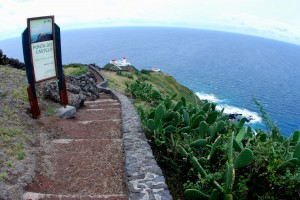 Now these viewpoints are used to locate whales and dolphins for cetaceans watch boat tours. There are several operators that can take you. Best time is August to late September when the water is warmer.
Now these viewpoints are used to locate whales and dolphins for cetaceans watch boat tours. There are several operators that can take you. Best time is August to late September when the water is warmer.
Maia is a village in a small bay between steep cliffs coloured by a puzzle of vines in corrals and the intense blue sea. It has also natural swimming pools and is the place to see the Aveiro waterfall.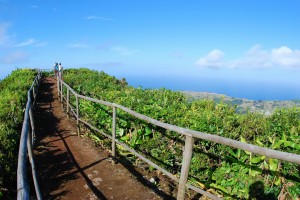
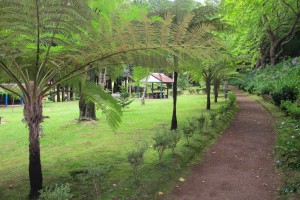
Don’t forget to visit Pico Alto, the highest point of the island. From its 590 metres you have a 360 degrees astonishing view. You will also be amazed by the intense smell of the flowers and trees and the different colours of Santa Maria: the blue and turquoise from the ocean, the gold and brown from the West plains and the several tones of green sprinkled with yellow flowers from the vegetation of the East.
There are a few very well kept forest parks around the island where you can spend a wonderful day surrounded by green lush vegetation and trees, like the Fontinhas Forest Park close to Pico das Cavacas, or Valeverde Forest Park, near Vila do Porto. Parks in Santa Maria have barbecue facilities that are usually full of wood ready to cook your lunch .There are also signalled pedestrian routes passing through them.



 Most of the islands traditions and festivities are religious with special devotion to Our Lady of Assumption, patron of Santa Maria and the Holy Ghost, which has a beautiful baroque church in Santo Espiríto village. Festivities go from April to September in different places of Santa Maria and if you get the chance to go to one “Império” don’t miss it. It is a religious tradition that includes the crowning of a child as emperor of the Holy Ghost and the free distribution of the Império soups, a typical soup served with a especial bread.
Most of the islands traditions and festivities are religious with special devotion to Our Lady of Assumption, patron of Santa Maria and the Holy Ghost, which has a beautiful baroque church in Santo Espiríto village. Festivities go from April to September in different places of Santa Maria and if you get the chance to go to one “Império” don’t miss it. It is a religious tradition that includes the crowning of a child as emperor of the Holy Ghost and the free distribution of the Império soups, a typical soup served with a especial bread.
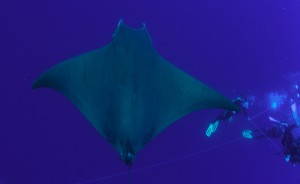 There is also more contemporaneous festivities such as an annual music festival in August, the “Marés d’Agosto”, that attracts lots of tourists to Praia Formosa.
There is also more contemporaneous festivities such as an annual music festival in August, the “Marés d’Agosto”, that attracts lots of tourists to Praia Formosa.
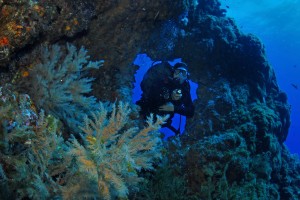 Santa Maria attractions don’t stay just in the island. There are three islets around with a very important role in the nesting of endemic and migrating birds. The Ilhéu do Romeiro also deservers a visit for its interior port and interesting stalagmites and stalactites formations.
Santa Maria attractions don’t stay just in the island. There are three islets around with a very important role in the nesting of endemic and migrating birds. The Ilhéu do Romeiro also deservers a visit for its interior port and interesting stalagmites and stalactites formations.
Further, at 37 kilometres from Santa Maria, the Ilhéu das Formigas is a set of eight islets with a lighthouse and a reef bank called Dollabarat. The surrounding waters are ecologically rich and are shelter and preferred place for breeding and feeding of many species including sharks, turtles and several cetaceans. Several operators can take you to Formigas and Dollabarat for a boat tour or for diving. Santa Maria has hotels in Vila do Porto, several rural tourism accommodation units spread around the island and camping facilities at Praia Formosa. Food is generally good and tasty and people are incredibly friendly .
. 

 Don’t miss trying the famous Santa Maria’s melons and biscuits. There are several activities to include on you must do list such as trekking, canyoning, para-sail, surf, windsurf, sports fishing and definitely diving.
Don’t miss trying the famous Santa Maria’s melons and biscuits. There are several activities to include on you must do list such as trekking, canyoning, para-sail, surf, windsurf, sports fishing and definitely diving.
It seems that the world crisis hasn’t arrived in Santa Maria. You can feel it in the children’s laughter, in the adult’s mood which is generally nice and polite, in the “good mornings” on the street, in the old ladies that don’t miss a good conversation and especially in the honest smiles you get everywhere you go.
You can feel it in the children’s laughter, in the adult’s mood which is generally nice and polite, in the “good mornings” on the street, in the old ladies that don’t miss a good conversation and especially in the honest smiles you get everywhere you go.  Safety is not yet a concern and you can still hitch hike anywhere in the island if needed. It’s a good way to get to know some local people, good stories, places to see and things to do.
Safety is not yet a concern and you can still hitch hike anywhere in the island if needed. It’s a good way to get to know some local people, good stories, places to see and things to do.
-Where to stay in Santa Maria Island.
-More about diving in Santa Maria Island.










